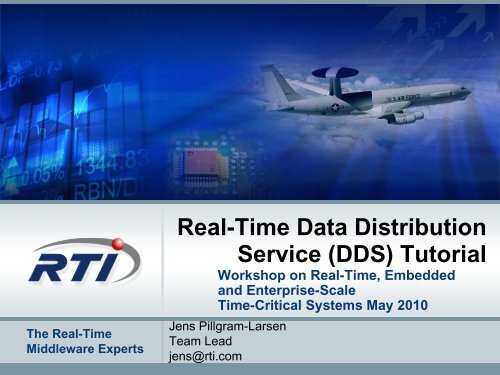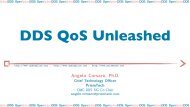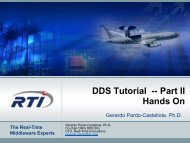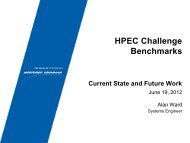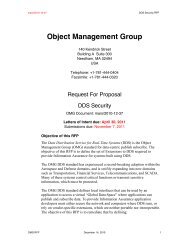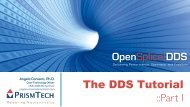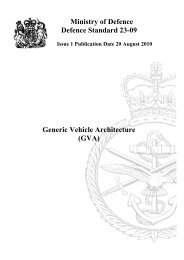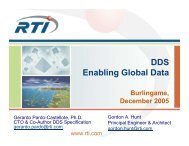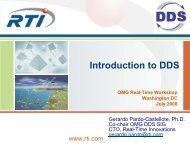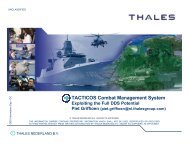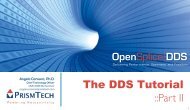DDS - Object Management Group Portals - OMG
DDS - Object Management Group Portals - OMG
DDS - Object Management Group Portals - OMG
You also want an ePaper? Increase the reach of your titles
YUMPU automatically turns print PDFs into web optimized ePapers that Google loves.
The Real-Time<br />
Middleware Experts<br />
Real-Time Data Distribution<br />
Service (<strong>DDS</strong>) Tutorial<br />
Workshop on Real-Time, Embedded<br />
and Enterprise-Scale<br />
Time-Critical Systems May 2010<br />
Jens Pillgram-Larsen<br />
Team Lead<br />
jens@rti.com
<strong>DDS</strong> in a Nutshell<br />
• <strong>DDS</strong> is Real-Time Data-Centric Networking Middleware<br />
• <strong>DDS</strong> focuses on<br />
– Performance<br />
– Configurability (Quality of Service)<br />
– Scalability<br />
– Integration<br />
<strong>DDS</strong> IS MUCH MORE THAN ENHANCED TCP!!!<br />
© 2009 Real-Time Innovations, Inc.<br />
2
History:<br />
<strong>DDS</strong> the Standard(s)<br />
• Data Distribution Service for Real-Time Systems<br />
– Joint submission (RTI, THALES, OIS)<br />
– <strong>DDS</strong> version 1.0 Adopted December 2004<br />
– <strong>DDS</strong> version 1.1 Adopted December 2005<br />
– <strong>DDS</strong> version 1.2 Adopted October 2006<br />
• Interoperability wire protocol<br />
– Joint submission (RTI and PrismTech)<br />
– <strong>DDS</strong>-RTPS version 1.2 adopted in July 2006<br />
– <strong>DDS</strong>-RTPS version 2.0 adopted in June 2007<br />
– <strong>DDS</strong>-RTPS version 2.1 approved in June 2008<br />
• Related Standards<br />
– UML Profile for <strong>DDS</strong> adopted June 2008<br />
– <strong>DDS</strong> for light weight CCM adopted 2008<br />
– Extensible and Dynamic Topic Types for <strong>DDS</strong> adopted 2010<br />
• Standards under Development<br />
– Native Language C++ API for <strong>DDS</strong><br />
– Web-Enabled <strong>DDS</strong><br />
– Java 5 PSM<br />
© 2009 Real-Time Innovations, Inc.
Agenda<br />
• Examples of <strong>DDS</strong> Usage<br />
• Benefits of <strong>DDS</strong><br />
• The <strong>DDS</strong> Model<br />
© 2009 Real-Time Innovations, Inc.<br />
4
<strong>DDS</strong> Mandated for Data-Distribution<br />
• DISR (formerly JTA)<br />
– DoD Information Technology<br />
Standards Registry<br />
• US Navy Open Architecture<br />
• FCS SOSCOE<br />
– Future Combat System –<br />
System of System Common<br />
Operating Environment<br />
• SPAWAR NESI<br />
– Net-centric Enterprise Solutions for<br />
Interoperability<br />
– Mandates <strong>DDS</strong> for Pub-Sub SOA<br />
© 2009 Real-Time Innovations, Inc.
<strong>DDS</strong> Adoption –<br />
Aerospace & Defense<br />
Boeing<br />
AWACS<br />
E2C Hawkeye<br />
Boeing<br />
Future Combat<br />
Systems<br />
Raytheon<br />
SSDS<br />
Lockheed<br />
AEGIS<br />
Insitu<br />
Unmanned<br />
Air Vehicles<br />
© 2009 Real-Time Innovations, Inc. 6
<strong>DDS</strong> Adoption –<br />
Transportation, Industrial<br />
WiTronix<br />
Train and vehicle<br />
Tracking<br />
Schneider Electric<br />
Industrial Automation<br />
Tokyo Japan<br />
Traffic Control<br />
Kuka<br />
Robotics<br />
EU and US<br />
Air Traffic<br />
<strong>Management</strong><br />
Varian<br />
Medical Instruments<br />
© 2009 Real-Time Innovations, Inc. 7
Study on impact of WS technologies for future European ATC: XML is<br />
not suitable for European Flight Data Distribution<br />
• Data size explodes 10X vs. CDR<br />
– Flight Plans go from 100KB to 1MB<br />
• Communication speed drops 20X<br />
Not good for Real-Time!!<br />
Source: Christian Esposito and Domenico Cotroneo, Dario Di Crescenzo.<br />
SELEX-SI/Consorzio SESM/University of Naples.<br />
“Flexible Communication Among <strong>DDS</strong> Publishers and Subscribers”<br />
July 2008, Real-Time Systems Workshop, Washington, DC<br />
© 2009 Real-Time Innovations, Inc.
Spacecraft Launch Control<br />
● The NASA KSC Constellation<br />
program will be the next generation<br />
of American manned spacecraft.<br />
● <strong>DDS</strong> delivered 300k instances, at<br />
400k msgs/sec with 5x the required<br />
throughput, at 1/5 the needed<br />
latency<br />
<strong>DDS</strong> connects thousands of sensors<br />
and actuators<br />
© 2009 Real-Time Innovations, Inc. COMPANY CONFIDENTIAL
Real-Time Pre-Trade Compliance<br />
• <strong>DDS</strong> value: replication between<br />
compliance servers -- no single point<br />
of failure<br />
• Driver: enforce and monitor<br />
regulatory and client-imposed pretrade<br />
investment restrictions<br />
• Integrate proprietary compliance<br />
engine with trading system<br />
System went live less than 3 months<br />
after licensing<br />
10
Automotive Safety<br />
• The VW Driver Assistance &<br />
Integrated Safety system<br />
– Provides steering assistance<br />
when swerving to avoid<br />
obstacles<br />
– Detects when the lane narrows<br />
or passing wide loads<br />
– Helps drivers to safely<br />
negotiate bends<br />
<strong>DDS</strong> bridges high speed networking<br />
to the CAN bus
Agenda<br />
• Examples of <strong>DDS</strong> usage<br />
• Benefits of <strong>DDS</strong><br />
• The <strong>DDS</strong> Model<br />
© 2009 Real-Time Innovations, Inc.<br />
12
Main Advantages of <strong>DDS</strong><br />
• Flexibility and Power of the data-centric model<br />
• Performance & Scalability<br />
• Rich set of built-in services<br />
• Interoperability across platforms and Languages<br />
• Natural integration with SOA building-blocks<br />
© 2009 Real-Time Innovations, Inc.
#1 Data-Centric vs. Message-Centric Design<br />
• Anyone can publish and subscribe<br />
– <strong>DDS</strong><br />
– JMS<br />
– AMQP<br />
– WS-Eventing<br />
– REST-MS<br />
• …but different technologies have very<br />
different models<br />
Treating them as interchangeable has ramifications:<br />
– Increased cost, risk<br />
– Decreased return on technology investment<br />
– Decreased performance<br />
© 2009 Real-Time Innovations, Inc. COMPANY CONFIDENTIAL 14
Data-Centric vs. Message-Centric Design<br />
Data-Centric<br />
• Infrastructure does<br />
understand your data<br />
– What data schema(s) will<br />
be used<br />
– Which objects are distinct<br />
from which other objects<br />
– What their lifecycles are<br />
– How to attach behavior<br />
(e.g. filters, QoS) to<br />
individual objects<br />
• Example technologies:<br />
– <strong>DDS</strong> API<br />
– RTPS (<strong>DDS</strong>I) protocol<br />
Message-Centric<br />
• Infrastructure does not<br />
understand your data<br />
– Opaque contents vary from<br />
message to message<br />
– No object identity;<br />
messages indistinguishable<br />
– Ad hoc lifecycle mgmt<br />
– Behaviors can only apply to<br />
whole data stream<br />
• Example technologies:<br />
– JMS API<br />
– AMQP protocol<br />
© 2009 Real-Time Innovations, Inc. COMPANY CONFIDENTIAL 15
Example: Data-Centric Track Data<br />
Data Schema<br />
id : string (key)<br />
x : float<br />
y : float<br />
Map this into XML; rows + cols<br />
Express content-based filters<br />
Propagate data efficiently<br />
Publish<br />
Dispose<br />
“AA123”<br />
X<br />
New<br />
“DL987”<br />
65.4<br />
32.1<br />
Update<br />
“AA123”<br />
56.7<br />
89.0<br />
45.6<br />
78.9<br />
New<br />
“AA123”<br />
Subscribe<br />
© 2009 Real-Time Innovations, Inc. COMPANY CONFIDENTIAL 16
Example: Data-Centric Track Data<br />
Publish<br />
Data Schema<br />
id : string (key)<br />
x : float<br />
Quality of Service<br />
History<br />
Deadline<br />
y : float<br />
Time-Based<br />
Filter<br />
• Once infrastructure understands objects, can attach<br />
QoS contracts to them<br />
• “Keep only the latest value” or “I need updates at<br />
this rate” make no sense unless per-object<br />
– Flight AA123 updates shouldn’t overwrite DL987, even if<br />
AA123 is updated more frequently<br />
– Update rate for one track shouldn’t change just because<br />
another track appeared<br />
Subscribe<br />
© 2009 Real-Time Innovations, Inc. COMPANY CONFIDENTIAL 17
Example: Message-Centric Track Data<br />
(No Data<br />
Schema,<br />
Limited QoS)<br />
Nothing to base filters, xforms on<br />
Error checking dev integration<br />
Self-describing data is verbose<br />
Publish<br />
“My app<br />
knows this<br />
means<br />
dispose.”<br />
0x00000006<br />
4141010203<br />
0042366666<br />
429DCCCD<br />
id=“AA123”<br />
x=float(45.6)<br />
y=float(78.9)<br />
Subscribe<br />
© 2009 Real-Time Innovations, Inc. COMPANY CONFIDENTIAL 18
When Message-Centric Design Works Well<br />
(Example: Securities order processing system)<br />
• No notion of objects or state beyond individual<br />
message; e.g. “Buy 12 shares IBM @ $12”<br />
• No need to filter based on content; e.g. all orders<br />
need to be processed eventually<br />
• No need for real-time QoS; e.g. maybe to you,<br />
“real-time” just means “fast”<br />
• Messaging interface is not integration interface<br />
between systems, providers, versions: one team<br />
implements both sides of interaction at same time<br />
© 2009 Real-Time Innovations, Inc. COMPANY CONFIDENTIAL 19
When Data-Centric Design Works Well<br />
(Examples: Distribution of track data, weather data)<br />
• <strong>Object</strong> lifecycle spans multiple updates;<br />
e.g. “Track AA123” or “Weather at (45.6°, 78.9°)”<br />
• Topic-per-object is impractical because<br />
– …objects are too numerous and/or<br />
– …their identities are unknown a priori and/or<br />
– …commonalities make them more manageable as a group.<br />
– Independent topic for each of 10K tracks<br />
For each (latitude, longitude) tuple<br />
• Need data-aware filtering and/or QoS enforcement; e.g.<br />
– “Give me the current state of all tracks” or<br />
– “Show me a weather map within this geographical region”<br />
• Integrating independently developed components<br />
and/or systems<br />
© 2009 Real-Time Innovations, Inc. COMPANY CONFIDENTIAL 20
Don’t Confuse Architecture and Technology<br />
• Can implement message-centric design with datacentric<br />
technology<br />
– Use generic data schemas (e.g. an opaque binary buffer)<br />
– Don’t define QoS contracts<br />
• Can implement data-centric design with messagecentric<br />
technology<br />
– Build layers on top to handle data schemas, data caching,<br />
QoS definition and enforcement, discovery, etc.<br />
– Capture service definitions informally in documentation<br />
• Define data/service architecture first,<br />
then select appropriate technology<br />
© 2009 Real-Time Innovations, Inc. COMPANY CONFIDENTIAL 21
Demo: <strong>DDS</strong> Concepts<br />
Display Area:<br />
Shows state of objects<br />
• Topics<br />
– Square, Circle, Triangle<br />
• Data types (schemas)<br />
– Shape (color, x, y, size)<br />
• Color is instance Key<br />
• QoS<br />
– Deadline, Liveliness<br />
– Reliability, Durability<br />
– History, Partition<br />
– Ownership<br />
Control Area:<br />
Allows selection of objects and QoS<br />
© 2009 Real-Time Innovations, Inc.
Demo: Quality of Service (QoS)<br />
Writers and readers state<br />
their needs<br />
• Topics<br />
– Square, Circle, Triangle<br />
• Data types (schemas)<br />
– Shape (color, x, y, size)<br />
• Color is instance Key<br />
• QoS<br />
– Deadline, Liveliness<br />
– Reliability, Durability<br />
– History, Partition<br />
– Ownership<br />
<strong>DDS</strong> delivers<br />
© 2009 Real-Time Innovations, Inc.
#2 Performance & Scalability<br />
<strong>DDS</strong> was designed to support high performance<br />
• <strong>DDS</strong> uses high-performance data-access APIs<br />
– Read data by array (no additional copies)<br />
– Buffer loaning for zero copy access<br />
• <strong>DDS</strong> Supports advanced features such as:<br />
– Message prioritization (via latency budget QoS)<br />
– Network prioritization (via transport priority QoS)<br />
– Source filtering (via Content-based and Time-based filters)<br />
• <strong>DDS</strong> does not require the presence of intermediate brokers<br />
– Applications can communicate directly peer-to-peer<br />
• <strong>DDS</strong> Protocol supports UDP, multicast and reliable multicast<br />
– Multicast can be used for high-performance scalability<br />
– Use of UDP avoids head-of-line blocking<br />
– Best efforts can be used for repetitive time-critical data<br />
© 2009 Real-Time Innovations, Inc.
Data-Distribution and Real-Time<br />
Messaging Technologies and Standards<br />
Web Services<br />
Java RTSJ (soft RT) RTSJ (hard RT)<br />
Java/RMI Java/JMS<br />
CORBA<br />
RT CORBA<br />
Data Distribution Service / <strong>DDS</strong><br />
Non-real-time Soft real-time Hard real-time Extreme real-time<br />
MPI<br />
© 2009 Adapted Real-Time from Innovations, NSWC-DD Inc. OA Documentation
Latency – (Linear Scale)<br />
<strong>DDS</strong>/JMS/Notification Service Comparison - Latency<br />
2500<br />
2000<br />
1500<br />
<strong>DDS</strong> JMS Notification Service<br />
1000<br />
500<br />
0<br />
4 8 16 32 64 128 256 512 1024 2048 4096 8192 16384<br />
Message Size (bytes)<br />
Message Length (samples)<br />
© 2009 Real-Time Innovations, Inc.<br />
Adapted from Vanderbilt presentation at July 2006 <strong>OMG</strong> Workshop on RT Systems
Jitter – (Linear Scale)<br />
<strong>DDS</strong>/CORBA Notification Service Comparison - Jitter<br />
100<br />
<strong>DDS</strong>/JMS/CORBA Notification Service Comparison - Jitter<br />
Standard Deviation (usecs)<br />
2000<br />
1800<br />
1600<br />
1400<br />
1200<br />
1000<br />
800<br />
600<br />
400<br />
200<br />
0<br />
Standard Deviation (usecs)<br />
80<br />
60<br />
<strong>DDS</strong> JMS Notification service<br />
<strong>DDS</strong> JMS Notification service<br />
40<br />
20<br />
0<br />
4 8 16 32 64 128 256 512 1024 2048 4096 8192 16384<br />
Message Length Message (samples) Size (bytes)<br />
4 8 16 32 64 128 256 512 1024 2048 4096 8192 16384<br />
Message Message Length Size (samples) (bytes)<br />
© 2009 Real-Time Innovations, Inc.<br />
Source: Vanderbilt presentation at July 2006 <strong>OMG</strong> Workshop on RT Systems
<strong>DDS</strong> compared to JMS<br />
[1000's sample/s]<br />
45<br />
40<br />
35<br />
30<br />
25<br />
20<br />
15<br />
10<br />
5<br />
0<br />
Throughput with a single publisher<br />
( 2KB messages )<br />
<strong>DDS</strong><br />
JMS<br />
2 4 6 9 11 18<br />
CPU load [%]<br />
Platform: Linux 2.6 on AMD Athlon, Dual core, 2.2 GHz<br />
© 2009 Real-Time Innovations, Inc.
Message bus architectures<br />
JMS<br />
Enterprise<br />
Messaging<br />
Centralized<br />
Clustered<br />
Enterprise<br />
Messaging<br />
Federated<br />
<strong>DDS</strong><br />
Peer to Peer<br />
© 2009 Real-Time Innovations, Inc.
#3 Powerful Services<br />
Included in the Standard:<br />
– Discovery<br />
– Ownership, Redundancy & Failover<br />
– Persistence (Durable) Data<br />
– Last value and historical caches<br />
Enabled by the <strong>DDS</strong> protocol:<br />
– Recording Service<br />
– Database Service<br />
– Web-Integration Service<br />
© 2009 Real-Time Innovations, Inc.
Discovery Service<br />
• <strong>DDS</strong> provides the means for an application to discover<br />
other participants in the Domain<br />
– And the Topics they Publish and Subscribe<br />
– And the Quality of Service of the remote endpoints<br />
• A participant can determine who it is communicating<br />
with…<br />
– And selectively decide who to communicate with…<br />
© 2009 Real-Time Innovations, Inc.
Ownership and High Availability<br />
Producer / Writer<br />
strength=10<br />
Producer / Writer<br />
strength=5<br />
Producer / Writer<br />
strength=1<br />
I1 Primary<br />
I1 Backup<br />
I2 Backup<br />
I2 Primary<br />
Topic T1<br />
I1<br />
I2<br />
• Owner determined per subject<br />
• Only extant writer with highest strength can publish a subject (or topic for<br />
non-keyed topics)<br />
• Automatic failover when highest strength writer:<br />
– Loses liveliness<br />
– Misses a deadline<br />
– Stops writing the subject<br />
• Shared Ownership allows any writer to update the subject<br />
© 2009 Real-Time Innovations, Inc.
Data Persistence<br />
A standalone service that persists data outside of the<br />
context of a DataWriter<br />
Can be configured for:<br />
• Redundancy<br />
• Load balancing<br />
Data<br />
Reader<br />
Data<br />
Writer<br />
Data<br />
Writer<br />
Global<br />
Data Space<br />
Data<br />
Reader<br />
Persistence<br />
Service<br />
Permanent<br />
Storage<br />
Persistence<br />
Service<br />
Permanent<br />
Storage<br />
© 2009 Real-Time Innovations, Inc.
Persistent Data Service<br />
• Modes:<br />
– High-performance “direct” model. Data flows in directly to subscribers and to the<br />
persistent service<br />
– Transactional “relay” mode persists first, then sends to subscribers<br />
• Fault-tolerant: Redundant services are supported<br />
Direct<br />
Mode<br />
Data<br />
Writer<br />
Relay<br />
Mode<br />
Data<br />
Writer<br />
Redundant<br />
Service<br />
Data<br />
Writer<br />
Persistence<br />
Service<br />
Persistence<br />
Service<br />
Persistence<br />
Service<br />
Persistence<br />
Service<br />
Data<br />
Reader<br />
Data<br />
Reader<br />
Data<br />
Reader<br />
Data<br />
Reader<br />
Data<br />
Reader<br />
Data<br />
Reader<br />
© 2009 Real-Time Innovations, Inc.
Last value cache<br />
• A last-value cache is already built-in into every Writer in<br />
the system<br />
– Can used in combination with a Durable Writer<br />
• A late joiner will automatically initialize to the last value<br />
• Last value cache can be configure with history depth<br />
greater than 1<br />
• The Persistence Service can be used to provide a last<br />
value cache for durable data<br />
© 2009 Real-Time Innovations, Inc.
Historical cache<br />
• A partial historical cache is already built-in into every Writer in the<br />
system<br />
– Can used in combination with a Durable Writer<br />
• The Persistence Service can be used to provide a historical cache<br />
with larger/unlimited depth<br />
• A late joiner will automatically initialize to the desired history<br />
– Currently amount of history can only be specified as message count.<br />
– Next release will also allow a age/time based specification.<br />
• Request for historical cache is done by creating a Reader with the<br />
desired history depth specified as a QoS<br />
© 2009 Real-Time Innovations, Inc.
#4 Interoperability<br />
• Protocol<br />
– Interoperability Wire protocol adopted in 2006<br />
• Languages: C/C++, Java, ADA, .NET<br />
• Systems/Platforms/Models<br />
– Data distribution (publishers and subscribers): <strong>DDS</strong><br />
– Data management (storage, retrieval, queries): SQL<br />
– ESB Integration, Business process integration: WSDL<br />
Distributed<br />
Node<br />
SQL<br />
SQL<br />
Distributed<br />
Node<br />
DBMS<br />
<strong>DDS</strong><br />
D T<br />
Global Data Space<br />
SQL<br />
Distributed<br />
Node<br />
Distributed<br />
Node<br />
WSDL<br />
DBMS<br />
DBMS<br />
<strong>DDS</strong><br />
Distributed<br />
Node<br />
© 2009 Real-Time Innovations, Inc.
#5 Natural with SOA building blocks<br />
Real-Time<br />
Devices<br />
Fault<br />
Tolerance<br />
Auditing &<br />
Recording<br />
WS-<strong>DDS</strong><br />
Real-Time Pub-Sub/Caching/Messaging<br />
SOA &<br />
Real-Time<br />
Web Services<br />
Database<br />
Event<br />
Processing<br />
Tools &<br />
Visualization<br />
© 2009 Real-Time Innovations, Inc.
Agenda<br />
• Examples of <strong>DDS</strong> usage<br />
• Main Benefits of <strong>DDS</strong><br />
• The <strong>DDS</strong> Model<br />
© 2009 Real-Time Innovations, Inc.<br />
39
<strong>DDS</strong> <strong>Object</strong> Model<br />
Data<br />
Writer<br />
Topic<br />
Data<br />
Reader<br />
Topic<br />
Publisher<br />
Offered<br />
QoS<br />
Subscriber<br />
Requested<br />
QoS<br />
Domain<br />
Participant<br />
Domain<br />
Participant<br />
Global Data Space<br />
• DomainParticipant – Allows application to join a <strong>DDS</strong> Domain (Global Data Space)<br />
• Topic – A string that addresses a group of objects in the Global Data Space<br />
– Each <strong>Object</strong> is identified by a Key (some fields within the object data)<br />
• Publisher, Subscriber – Pools resources for DataWriters and DataReaders<br />
• DataWriter – Declares intent to publish a Topic and provides type-safe operations to write/send<br />
data<br />
• DataReader – Declares intent to subscribe to a Topic and provides type-safe operations to<br />
read/receive data<br />
© 2009 Real-Time Innovations, Inc.
<strong>DDS</strong> Type Model<br />
1. Type System: abstract definition of what types<br />
can exist<br />
• Expressed as UML meta-model<br />
• Including substitutability, compatibility rules<br />
• Mostly familiar from IDL<br />
2. Type Representations: languages for<br />
describing types<br />
• IDL<br />
• XML and XSD<br />
• TypeCode<br />
3. Data Representations: languages for<br />
describing data<br />
– CDR<br />
– XML<br />
© 2009 Real-Time Innovations, Inc.
<strong>DDS</strong> Type Model<br />
4. Language Binding: programming APIs<br />
– “Plain Language”: extension of existing IDL-to-language<br />
bindings<br />
– Dynamic: reflective API for types and objects, defined in UML<br />
(conceptual model) and IDL (API)<br />
5. Use by <strong>DDS</strong>: application of type/data representations to<br />
middleware<br />
– Data encapsulation, QoS compatibility<br />
– Type compatibility as applied to endpoint matching<br />
– Built-in types<br />
© 2009 Real-Time Innovations, Inc.
<strong>DDS</strong> Communication Model<br />
Provides a “Global Data Space” that is accessible to all interested<br />
applications.<br />
– Data objects addressed by Domain, Topic and Key<br />
– Subscriptions are decoupled from Publications<br />
– Contracts established by means of QoS<br />
– Automatic discovery and configuration<br />
Participant<br />
Pub<br />
Pub<br />
Participant<br />
Sub<br />
Track,1<br />
Track,2<br />
Track,3<br />
Sub<br />
Participant<br />
Global Data Space<br />
Participant<br />
Pub<br />
Alarm<br />
Sub<br />
Participant<br />
© 2009 Real-Time Innovations, Inc.
<strong>DDS</strong> Data-Centric Model<br />
“Global Data Space” generalizes Subject-Based Addressing<br />
– Domains provide a level of isolation<br />
– Topic groups homogeneous subjects (same data-type & meaning)<br />
– Key is a generalization of subject<br />
• Key can be any set of fields, not limited to a “x.y.z …” formatted string<br />
Data Writer<br />
Data Writer<br />
Data <strong>Object</strong><br />
Data Reader<br />
Data Reader<br />
Data Writer<br />
Data Reader<br />
© 2009 Real-Time Innovations, Inc.
<strong>DDS</strong> Data-Centric Model<br />
“Global Data Space” generalizes Subject-Based Addressing<br />
– Domains provide a level of isolation<br />
– Topic groups homogeneous subjects (same data-type & meaning)<br />
– Key is a generalization of subject<br />
• Key can be any set of fields, not limited to a “x.y.z …” formatted string<br />
Data Writer<br />
Topic<br />
Data Reader<br />
Data Writer<br />
Data Reader<br />
Data Writer<br />
Data Reader<br />
© 2009 Real-Time Innovations, Inc.
<strong>DDS</strong> Data-Centric Model<br />
“Global Data Space” generalizes Subject-Based Addressing<br />
– Domains provide a level of isolation<br />
– Topic groups homogeneous subjects (same data-type & meaning)<br />
– Key is a generalization of subject<br />
• Key can be any set of fields, not limited to a “x.y.z …” formatted string<br />
Data Writer<br />
Key (subject)<br />
Data Reader<br />
Data Writer<br />
Data Reader<br />
Data Writer<br />
Data Reader<br />
© 2009 Real-Time Innovations, Inc.
<strong>DDS</strong> Data-Centric Model<br />
• <strong>DDS</strong> is Pub-Sub of data objects<br />
– The object is strongly typed<br />
– <strong>DDS</strong> publishes the state of the data object<br />
– <strong>DDS</strong> data objects have an identity<br />
A <strong>DDS</strong> Sample is more than a Message<br />
© 2009 Real-Time Innovations, Inc.<br />
47
<strong>DDS</strong> QoS: Quality of Service<br />
QoS Policy<br />
DURABILITY<br />
HISTORY (per subject)<br />
READER DATA LIFECYCLE<br />
WRITER DATA LIFECYCLE<br />
LIFESPAN<br />
ENTITY FACTORY<br />
RESOURCE LIMITS<br />
RELIABILITY<br />
TIME BASED FILTER<br />
DEADLINE<br />
CONTENT FILTERS<br />
QoS Policy<br />
USER DATA<br />
TOPIC DATA<br />
GROUP DATA<br />
PARTITION<br />
PRESENTATION<br />
DESTINATION ORDER<br />
OWNERSHIP<br />
OWNERSHIP STRENGTH<br />
LIVELINESS<br />
LATENCY BUDGET<br />
TRANSPORT PRIORITY<br />
© 2009 Real-Time Innovations, Inc.
Q/A<br />
Thank You!<br />
© 2009 Real-Time Innovations, Inc.<br />
49


